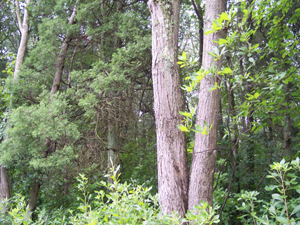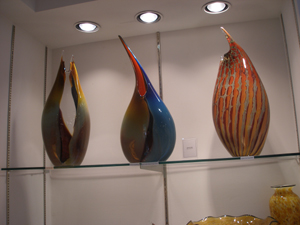 Roy lived in a house like this
Here we have found a much greater variety of occupations, towns,
people, and lifestyles.
Roy lived in a house like this
Here we have found a much greater variety of occupations, towns,
people, and lifestyles.
We have learned that you can't describe New Jersey in any simple way. We began our visit
in northeastern New
Jersey, learning that it is economically and spiritually tied to New York City. Now,
farther south, we are
within commuting distance of Philadelphia.
 Roy lived in a house like this
Here we have found a much greater variety of occupations, towns,
people, and lifestyles.
Roy lived in a house like this
Here we have found a much greater variety of occupations, towns,
people, and lifestyles.
Shortly after we arrived here, we made an excursion to Collingswood, where Elsa's father lived in the early 1930s, working for the Travelers Insurance Company. Roy Walther supervised fourteen girls, as he loved to remember; he and his friend Al Reed enjoyed parties where they would drink and dance the night away.
The 1930 census showed Roy boarding at 521 Haddon Avenue, which is
Collingswood's long main street,
lined with stores. Number 521 has recently been remodeled and
combined with its neighbor 523 into a
 Looking into the pine forest
law office, but across the street we could see what it looked like
before remodelling. It's a typical building
in this part of town - two homes side by side with a common wall,
shared porch,
separate front doors, and a
tiny garden in back.
Looking into the pine forest
law office, but across the street we could see what it looked like
before remodelling. It's a typical building
in this part of town - two homes side by side with a common wall,
shared porch,
separate front doors, and a
tiny garden in back.
Our second trip, on a cool rainy morning,
took us to the New Jersey pine barrens. Over 20% of the state consists
of this flat sandy forested land, not good for farming, so never heavily
settled. In a few short miles one leaves
the densely settled suburban towns for a rural wilderness. What buildings
there are tend to be quite old and
ramshackle, and it's like driving into the past. There are sandy ruts
which date from Colonial times and penetrate
 A cranberry bog
the pine barrens, but with all the recent rain we did not try a
four-wheel drive adventure!
A cranberry bog
the pine barrens, but with all the recent rain we did not try a
four-wheel drive adventure!
The pine barrens are home to many of New Jersey's famed cranberry bogs, and many of the current residents are engaged in cranberry farming. Bog iron was found in abundance and used for cannonballs during the Revolution. Batsto Village was engaged in a large number of forestry and agricultural projects towards the end of the 19th century, and is today a State Historical Park.
The pine barrens
 The entrance to Batsto village
were also home to the Jukes and the Kallikaks, families which
were used to “prove” that anti-social
behavior and feeble-mindedness were inherited, and provided
fuel for the proposals of early eugenecists.
The entrance to Batsto village
were also home to the Jukes and the Kallikaks, families which
were used to “prove” that anti-social
behavior and feeble-mindedness were inherited, and provided
fuel for the proposals of early eugenecists.
A second trip to South Jersey took us to WheatonArts, which
is primarily a glass and pottery center in Millville.
Resident artists and craftspeople demonstrate a variety of
glassmaking and ceramic skills, while visiting artists
and fellows take advantage of the large-scale glassmaking
equipment available at the site. The gem of WheatonArts
is the American Glass Museum,
 Glass blowing demonstration
which carefully depicts the story of American glass from
early work at Millville in
the colonial period up through the modern creations of
fine artists. We enjoyed looking at all the glass products
from baby bottles to marbles, stemware to paperweights,
light bulbs to coffins to modern sculpture, and would have
stayed longer if we hadn't wanted our lunch!
Glass blowing demonstration
which carefully depicts the story of American glass from
early work at Millville in
the colonial period up through the modern creations of
fine artists. We enjoyed looking at all the glass products
from baby bottles to marbles, stemware to paperweights,
light bulbs to coffins to modern sculpture, and would have
stayed longer if we hadn't wanted our lunch!
We finished off that trip with a drive along the south
shore of New Jersey, penetrating through to Delaware Bay at
Bay Side,
 Modern glass sculpture
which is not much more than a name on the map. It's just
past Greenwich, which has a monument to the
patriots who burned British tea in 1776. Immediately next
to the Bay are grassy marshes and wetlands which are
protected refuges for waterfowl, but just inland is some of
New Jersey's richest farmland, with fields of corn,
beans, and wheat and many good-size vegetable gardens.
Modern glass sculpture
which is not much more than a name on the map. It's just
past Greenwich, which has a monument to the
patriots who burned British tea in 1776. Immediately next
to the Bay are grassy marshes and wetlands which are
protected refuges for waterfowl, but just inland is some of
New Jersey's richest farmland, with fields of corn,
beans, and wheat and many good-size vegetable gardens.
 Bay Side, New Jersey
We saw dozens of tree farms and
extensive peach orchards. In this remote farmland we
found that other drivers and even workers would wave as we
drove past; you won't find that kind of friendliness
in the bedroom communities!
Bay Side, New Jersey
We saw dozens of tree farms and
extensive peach orchards. In this remote farmland we
found that other drivers and even workers would wave as we
drove past; you won't find that kind of friendliness
in the bedroom communities!
On the other hand, the two county seats of Bridgeton and
Salem were unattractive, in our opinion. Both cities
showed a depressed economy, with many boarded up buildings
and many idlers in the streets. Bridgeton had a huge
 New Sweden Farm Museum -
New Sweden Farm Museum -
Fenced and locked up
park, evidently nearly out of funds, for the 1638 New Sweden
farm museum was locked up, and the ramshackle zoo
appeared to be completely unattended.
Four years ago we drove north along the Jersey Shore and were flabbergasted by the sudden change from opulence to poverty as we crossed the boundary from Deal to Asbury Park. This year we are spending four weeks in New Jersey, and our explorations continue to reveal the same shocking differences from one town to another. While all states have both prosperous and poor regions, New Jersey seems to take the prize for the rapidity in which neighborhoods can change. Despite being one of the smaller states in area, New Jersey seems like many different states crowded together.